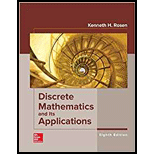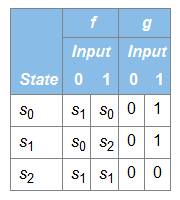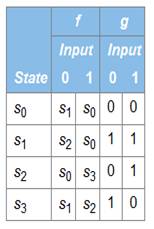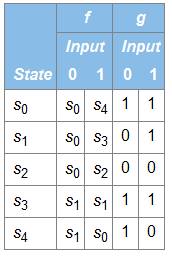
DISCRETE MATHEMATICS+ITS APPL. (LL)-W/A
8th Edition
ISBN: 9781260521337
Author: ROSEN
Publisher: MCG
expand_more
expand_more
format_list_bulleted
Textbook Question
Chapter 13.2, Problem 3E
Find the output generated from the input string 01110 for the finite-state machine with the state table in
a) Exercise 1(a).
b) Exercise 1(b).
c) Exercise 1(c).
a) 
b) 
c) 
Expert Solution & Answer
Want to see the full answer?
Check out a sample textbook solution
Students have asked these similar questions
No chatgpt pls will upvote
Only 100% sure experts solve it correct complete solutions okkk don't use chat gpt or other ai okk
Question 2.
i. Suppose that the random variable X takes two possible values 1 and -1, and P(X = 1) =
P(X-1)=1/2. Let Y=-X. Are X and Y the same random variable? Do X and Y
have the same distribution? Explain your answer.
ii. Suppose that the random variable X~N(0, 1), let Y=-X. Are X and Y the same random
variable? Do X and Y have the same distribution? Explain your answer.
Chapter 13 Solutions
DISCRETE MATHEMATICS+ITS APPL. (LL)-W/A
Ch. 13.1 - Exercises 1-3 refer to the grammar with start...Ch. 13.1 - Exercises 1-3 refer to the grammar with start...Ch. 13.1 - Prob. 3ECh. 13.1 - Let G=(V,T,S,P) be the phrase-structure grammar...Ch. 13.1 - Prob. 5ECh. 13.1 - Prob. 6ECh. 13.1 - Prob. 7ECh. 13.1 - Show that the grammar given in Example 5 generates...Ch. 13.1 - Prob. 9ECh. 13.1 - Prob. 10E
Ch. 13.1 - Construct a derivation of 021222 in the grammar...Ch. 13.1 - Show that the grammar given in Example 7 generates...Ch. 13.1 - s13. Find a phrase-structure grammar for each of...Ch. 13.1 - Find a phrase-structure grammar for each of these...Ch. 13.1 - Find a phrase-structure grammar for each of these...Ch. 13.1 - Construct phrase-structure grammars to generate...Ch. 13.1 - Construct phrase-structure grammars to generate...Ch. 13.1 - Construct phrase-structure grammars to generate...Ch. 13.1 - Prob. 19ECh. 13.1 - A palindrome is a string that reads the same...Ch. 13.1 - Let G1 and G2 be context-free grammars, generating...Ch. 13.1 - Prob. 22ECh. 13.1 - Construct derivation trees for the sentences in...Ch. 13.1 - Let G be the grammar with V={a,b,c,S};T={a,b,c} ;...Ch. 13.1 - Prob. 25ECh. 13.1 - Prob. 26ECh. 13.1 - Prob. 27ECh. 13.1 - a) Explain what the productions are in a grammar...Ch. 13.1 - Prob. 29ECh. 13.1 - a) Construct a phrasestructure grammar for the set...Ch. 13.1 - Give production rules in Backus-Naur form for an...Ch. 13.1 - Prob. 32ECh. 13.1 - Prob. 33ECh. 13.1 - Prob. 34ECh. 13.1 - Prob. 35ECh. 13.1 - Prob. 36ECh. 13.1 - Prob. 37ECh. 13.1 - Prob. 38ECh. 13.1 - Prob. 39ECh. 13.1 - Prob. 40ECh. 13.1 - Prob. 41ECh. 13.1 - Let G be a grammar and let R be the relation...Ch. 13.2 - Draw the state diagrams for the finite-state...Ch. 13.2 - Give the state tables for the finite-state machine...Ch. 13.2 - Find the output generated from the input string...Ch. 13.2 - Find the output generated from the input string...Ch. 13.2 - Find the output for each of these input strings...Ch. 13.2 - Find the output for each of these input strings...Ch. 13.2 - Construct a finite-state machine that models an...Ch. 13.2 - Prob. 8ECh. 13.2 - Construct a finite-state machine that delays an...Ch. 13.2 - Construct a finite-state machine that changes...Ch. 13.2 - Construct a finite-state machine for the log-on...Ch. 13.2 - Construct a finite-state machine for lock that...Ch. 13.2 - Construct a finite-state machine for a toll...Ch. 13.2 - Construct a finite-state machine for entering a...Ch. 13.2 - Construct a finite-state machine for a restricted...Ch. 13.2 - Construct a finite-state machine that gives an...Ch. 13.2 - Prob. 17ECh. 13.2 - Construct a finite-state machine that determines...Ch. 13.2 - Construct a finite-state machine that determines...Ch. 13.2 - Prob. 20ECh. 13.2 - Prob. 21ECh. 13.2 - Find the output string generated by the Moore...Ch. 13.2 - Prob. 23ECh. 13.2 - Construct a Moore machine that gives an output of...Ch. 13.2 - Prob. 25ECh. 13.3 - Prob. 1ECh. 13.3 - 2. Show that if A is a set of strings, then.
Ch. 13.3 - Find all pairs of sets of strings A and B for...Ch. 13.3 - Show that these equalities hold. a) {}*={} b)...Ch. 13.3 - Prob. 5ECh. 13.3 - Prob. 6ECh. 13.3 - Prob. 7ECh. 13.3 - Prob. 8ECh. 13.3 - Prob. 9ECh. 13.3 - Determine whether the string 01001 is in each of...Ch. 13.3 - Determine whether each of these strings is...Ch. 13.3 - Determine whether each of these strings is...Ch. 13.3 - Determine whether all the strings in each of these...Ch. 13.3 - Show that if M=(S,I,f,so,F) is a deterministic...Ch. 13.3 - Given a finite-state automaton M=(S,I,f,so,F) ,...Ch. 13.3 - In Exercises 16—22 find the language recognized by...Ch. 13.3 - In Exercises 16—22 find the language recognized by...Ch. 13.3 - Prob. 18ECh. 13.3 - Prob. 19ECh. 13.3 - In Exercises 16—22 find the language recognized by...Ch. 13.3 - In Exercises 16—22 find the language recognized by...Ch. 13.3 - Prob. 22ECh. 13.3 - Construct a deterministic finite-state automaton...Ch. 13.3 - Construct a deterministic finite-state automaton...Ch. 13.3 - Construct a deterministic finite-state automaton...Ch. 13.3 - Construct a deterministic finite-state automaton...Ch. 13.3 - Prob. 27ECh. 13.3 - Construct a deterministic finite-state automaton...Ch. 13.3 - Prob. 29ECh. 13.3 - Construct a deterministic finite-state automaton...Ch. 13.3 - Construct a deterministic finite-state automaton...Ch. 13.3 - Construct a deterministic finite-state automaton...Ch. 13.3 - Prob. 33ECh. 13.3 - Prob. 34ECh. 13.3 - Prob. 35ECh. 13.3 - Prob. 36ECh. 13.3 - Prob. 37ECh. 13.3 - Prob. 38ECh. 13.3 - Prob. 39ECh. 13.3 - Use Exercise 39 finite-state automata constructed...Ch. 13.3 - Prob. 41ECh. 13.3 - Prob. 42ECh. 13.3 - Prob. 43ECh. 13.3 - Prob. 44ECh. 13.3 - Prob. 45ECh. 13.3 - In Exercises 43-49 find the language recognized by...Ch. 13.3 - Prob. 47ECh. 13.3 - In Exercises 43-49 find the language recognized by...Ch. 13.3 - Prob. 49ECh. 13.3 - Find a deterministic finite-state automaton that...Ch. 13.3 - Prob. 51ECh. 13.3 - Find a deterministic finite-state automaton that...Ch. 13.3 - Find a deterministic finite-state automaton that...Ch. 13.3 - Find a deterministic finite-state automaton that...Ch. 13.3 - Find a deterministic finite-state automaton that...Ch. 13.3 - Find a nondeterministic finite-state automaton...Ch. 13.3 - Prob. 57ECh. 13.3 - Prob. 58ECh. 13.3 - Prob. 59ECh. 13.3 - Prob. 60ECh. 13.3 - Prob. 61ECh. 13.3 - Prob. 62ECh. 13.4 - Describe in words the strings in each of these...Ch. 13.4 - Prob. 2ECh. 13.4 - Prob. 3ECh. 13.4 - Prob. 4ECh. 13.4 - Express each of these sets using a regular...Ch. 13.4 - Express each of these sets using a regular...Ch. 13.4 - Express each of these sets using a regular...Ch. 13.4 - Construct deterministic finite-state automata that...Ch. 13.4 - Construct nondeterministic finite-state automata...Ch. 13.4 - Construct nondeterministic finite-state automata...Ch. 13.4 - Show that if A is a regular set, then AR, the set...Ch. 13.4 - Using the construction described in the proof of...Ch. 13.4 - Using the construction described in the proof of...Ch. 13.4 - Construct a nondeterministic finite-state...Ch. 13.4 - In Exercises 15-17 conflict a regular grammar...Ch. 13.4 - In Exercises 15-17 conflict a regular grammar...Ch. 13.4 - In Exercises 15-17 conflict a regular grammar...Ch. 13.4 - Show that the finite-state automaton constructed...Ch. 13.4 - Show that the regular grammar constructed from a...Ch. 13.4 - Show that every nondeterministic finite-state...Ch. 13.4 - Let M=(S,I,f,s0,F) be a deterministic finite-state...Ch. 13.4 - One important technique used to prove that certain...Ch. 13.4 - Show that the set 02n1nn=0,1,2,... is not regular...Ch. 13.4 - Show that the set {1n2n=0,1,2,...} is not regular...Ch. 13.4 - Show that the set of palindromes over {0, 1} is...Ch. 13.4 - Prob. 26ECh. 13.4 - Prob. 27ECh. 13.4 - Prob. 28ECh. 13.4 - Prob. 29ECh. 13.4 - Prob. 30ECh. 13.4 - Use Exercise 29 to show that the language...Ch. 13.5 - Let T be the Turing machine defined by the...Ch. 13.5 - Let T be the Turing machine defined by the...Ch. 13.5 - What does the Turing machine defined by the...Ch. 13.5 - What does the Turing machine described by the...Ch. 13.5 - What does the Turing machine described by the...Ch. 13.5 - Construct a Turing machine with tape 0, 1, and B...Ch. 13.5 - Construct a Turning machine with tape symbols 0,...Ch. 13.5 - Construct a Turing machine with tape symbols 0, 1,...Ch. 13.5 - Construct a Turing machine with tape symbols 0, 1,...Ch. 13.5 - Construct a Turing machine with tape symbols 0, 1,...Ch. 13.5 - Construct a Turing machine that recognizes the set...Ch. 13.5 - Construct a Turing machine that recognizes the set...Ch. 13.5 - Construct a Turing machine that recognizes the set...Ch. 13.5 - Show at each step the contents of the tape of the...Ch. 13.5 - Explain why the Turing machine in Example 3...Ch. 13.5 - Construct a Turing machine that recognizes the set...Ch. 13.5 - Construct a Turing machine that recognizes the set...Ch. 13.5 - Construct a Turing machine that computes the...Ch. 13.5 - Construct a Turing machine that computes the...Ch. 13.5 - Construct a Turing machine that computes the...Ch. 13.5 - Construct a Turing machine that computes the...Ch. 13.5 - Construct a Turing machine that computes the...Ch. 13.5 - Construct a Turing machine that computes the...Ch. 13.5 - Construct a Turing machine that computes the...Ch. 13.5 - Construct a Turing machine that computes the...Ch. 13.5 - Construct a Turning machine that computes the...Ch. 13.5 - Prob. 27ECh. 13.5 - Prob. 28ECh. 13.5 - Which of the following problems is a decision...Ch. 13.5 - Which of the following problems is a decision...Ch. 13.5 - Prob. 31ECh. 13.5 - Show that the function B(n) cannot be computed by...Ch. 13 - a) Define a phrase-structure grammar. b) What does...Ch. 13 - a) What is the language generated by a...Ch. 13 - Prob. 3RQCh. 13 - Prob. 4RQCh. 13 - Prob. 5RQCh. 13 - a) What is a finite-state machine? b) Show how a...Ch. 13 - Prob. 7RQCh. 13 - Prob. 8RQCh. 13 - Prob. 9RQCh. 13 - Prob. 10RQCh. 13 - a) Define a nondeterministic finite-state...Ch. 13 - a) Define the set of regular expressions over a...Ch. 13 - Prob. 13RQCh. 13 - Prob. 14RQCh. 13 - Prob. 15RQCh. 13 - Prob. 16RQCh. 13 - Describe how Turing machines are used to recognize...Ch. 13 - Prob. 18RQCh. 13 - Prob. 19RQCh. 13 - Prob. 1SECh. 13 - Prob. 2SECh. 13 - Prob. 3SECh. 13 - Prob. 4SECh. 13 - Prob. 5SECh. 13 - Prob. 6SECh. 13 - Prob. 7SECh. 13 - Prob. 8SECh. 13 - Prob. 9SECh. 13 - Prob. 10SECh. 13 - Prob. 11SECh. 13 - Prob. 12SECh. 13 - Prob. 13SECh. 13 - Construct a finite-state machine with output that...Ch. 13 - Construct a finite-state machine with output that...Ch. 13 - Prob. 16SECh. 13 - Prob. 17SECh. 13 - Prob. 18SECh. 13 - Construct a deterministic finite-state automaton...Ch. 13 - Prob. 20SECh. 13 - Prob. 21SECh. 13 - Prob. 22SECh. 13 - Prob. 23SECh. 13 - Prob. 24SECh. 13 - Prob. 25SECh. 13 - Show that {02nnN} is not regular. You may use the...Ch. 13 - Prob. 27SECh. 13 - Prob. 28SECh. 13 - Construct a Turing machine that computes the...Ch. 13 - Prob. 30SECh. 13 - Prob. 1CPCh. 13 - Prob. 2CPCh. 13 - Prob. 3CPCh. 13 - Prob. 4CPCh. 13 - Given the state table of a Moore machine and an...Ch. 13 - Given the state table of a Mealy machine and an...Ch. 13 - Given the state table of a deterministic...Ch. 13 - Prob. 8CPCh. 13 - Prob. 9CPCh. 13 - Prob. 10CPCh. 13 - Given a regular grammar, construct a finite-state...Ch. 13 - Given a finite-state automaton, construct a...Ch. 13 - Prob. 13CPCh. 13 - Solve the busy beaver problem for two states by...Ch. 13 - Prob. 2CAECh. 13 - Prob. 3CAECh. 13 - Prob. 4CAECh. 13 - Prob. 5CAECh. 13 - Prob. 1WPCh. 13 - Describe the Backus-Naur form (and extended...Ch. 13 - Explain how finite-state machines are used by...Ch. 13 - Explain how finite-state machines are used in the...Ch. 13 - Explain how finite-state machines are used in...Ch. 13 - Compare the use of Moore machines versus Mealy...Ch. 13 - Explain the concept of minimizing finite-state...Ch. 13 - Give the definition of cellular automata, Explain...Ch. 13 - Define a pushdown automaton. Explain how pushdown...Ch. 13 - Define a linear-bounded automaton. Explain how...Ch. 13 - Prob. 11WPCh. 13 - Prob. 12WPCh. 13 - Prob. 13WPCh. 13 - Show that a Turing machine can simulate any action...Ch. 13 - Prob. 15WPCh. 13 - Describe the basic concepts of the lambda-calculus...Ch. 13 - Show that a Turing machine as defined in this...Ch. 13 - Prob. 18WP
Knowledge Booster
Learn more about
Need a deep-dive on the concept behind this application? Look no further. Learn more about this topic, subject and related others by exploring similar questions and additional content below.Similar questions
- Problem 4. Let f(x, y) = { Find P(X <1/2|Y = 1/2). c(x + y²) 0arrow_forwardQize f(x) x + 2x2 - 2 x² + 4x² - 4 Solve the equation using Newton Raphsonarrow_forward3. Consider the following theorem: Theorem: If n is an odd integer, then n³ is an odd integer. Note: There is an implicit universal quantifier for this theorem. Technically we could write: For all integers n, if n is an odd integer, then n³ is an odd integer. (a) Explore the statement by constructing at least three examples that satisfy the hypothesis, one of which uses a negative value. Verify the conclusion is true for each example. You do not need to write your examples formally, but your work should be easy to follow. (b) Pick one of your examples from part (a) and complete the following sentence frame: One example that verifies the theorem is when n = We see the hypothesis is true because and the conclusion is true because (c) Use the definition of odd to construct a know-show table that outlines the proof of the theorem. You do not need to write a proof at this time.arrow_forwardmatrix 4arrow_forwardPlease ensure that all parts of the question are answered thoroughly and clearly. Include a diagram to help explain answers. Make sure the explanation is easy to follow. Would appreciate work done written on paper. Thank you.arrow_forwardLogin HAC Home View Summary MwMerriam-Webster: A... Lizard Point Quizze... G Home | Gimkit Quizlet Live | Quizlet K! Kahoot! 7.2 HW Central Angles, Arcs, and Arc Lengths POSSIBLE POINTS: 6.67 11. If myQ=(y+7), mQR = (x+11), mRS = (3y), and mST = 65°, find the values of x and y. R V X = y = W S T q W a It N S C % 65 54 # m d DELL 96 t y 0 27 & J * 00 8 x= y= f g h J k X C V b n 3 ES 1 Feb 26 alt ctrlarrow_forwardExplore this statement by constructing at least three examples, one of which must be a negative integer. Indicate if the statement is true or false for each example.arrow_forwardFind binomial probability if: x = 8, n = 10, p = 0.7 x= 3, n=5, p = 0.3 x = 4, n=7, p = 0.6 Quality Control: A factory produces light bulbs with a 2% defect rate. If a random sample of 20 bulbs is tested, what is the probability that exactly 2 bulbs are defective? (hint: p=2% or 0.02; x =2, n=20; use the same logic for the following problems) Marketing Campaign: A marketing company sends out 1,000 promotional emails. The probability of any email being opened is 0.15. What is the probability that exactly 150 emails will be opened? (hint: total emails or n=1000, x =150) Customer Satisfaction: A survey shows that 70% of customers are satisfied with a new product. Out of 10 randomly selected customers, what is the probability that at least 8 are satisfied? (hint: One of the keyword in this question is “at least 8”, it is not “exactly 8”, the correct formula for this should be = 1- (binom.dist(7, 10, 0.7, TRUE)). The part in the princess will give you the probability of seven and less than…arrow_forwardplease answer these questionsarrow_forward2. Consider the following statement: For each natural number n, (3.2n+2.3n+1) is a prime number. (a) Explore this statement by completing the table below for n = 2,3 and two additional values of n of your choosing (notice n = 1 has been completed for you). One of your rows should contain a counterexample. n 1 3.2 2.3 +1 3.212.31 + 1 = 13 prime or composite? prime 2 3 (b) Write a formal counterexample argument for the statement using the template fromarrow_forwardPlease ensure that all parts of the question are answered thoroughly and clearly. Include a diagram to help explain answers. Make sure the explanation is easy to follow. Would appreciate work done written on paper. Thank you.arrow_forwardPlease ensure that all parts of the question are answered thoroughly and clearly. Include a diagram to help explain answers. Make sure the explanation is easy to follow. Would appreciate work done written on paper. Thank you.arrow_forwardarrow_back_iosSEE MORE QUESTIONSarrow_forward_ios
Recommended textbooks for you
 Elements Of Modern AlgebraAlgebraISBN:9781285463230Author:Gilbert, Linda, JimmiePublisher:Cengage Learning,
Elements Of Modern AlgebraAlgebraISBN:9781285463230Author:Gilbert, Linda, JimmiePublisher:Cengage Learning, Linear Algebra: A Modern IntroductionAlgebraISBN:9781285463247Author:David PoolePublisher:Cengage Learning
Linear Algebra: A Modern IntroductionAlgebraISBN:9781285463247Author:David PoolePublisher:Cengage Learning Elementary Geometry For College Students, 7eGeometryISBN:9781337614085Author:Alexander, Daniel C.; Koeberlein, Geralyn M.Publisher:Cengage,
Elementary Geometry For College Students, 7eGeometryISBN:9781337614085Author:Alexander, Daniel C.; Koeberlein, Geralyn M.Publisher:Cengage,

Elements Of Modern Algebra
Algebra
ISBN:9781285463230
Author:Gilbert, Linda, Jimmie
Publisher:Cengage Learning,

Linear Algebra: A Modern Introduction
Algebra
ISBN:9781285463247
Author:David Poole
Publisher:Cengage Learning

Elementary Geometry For College Students, 7e
Geometry
ISBN:9781337614085
Author:Alexander, Daniel C.; Koeberlein, Geralyn M.
Publisher:Cengage,
Finite State Machine (Finite Automata); Author: Neso Academy;https://www.youtube.com/watch?v=Qa6csfkK7_I;License: Standard YouTube License, CC-BY
Finite State Machine (Prerequisites); Author: Neso Academy;https://www.youtube.com/watch?v=TpIBUeyOuv8;License: Standard YouTube License, CC-BY